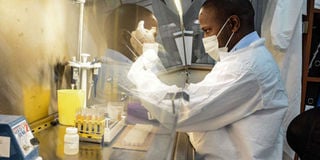Premium
COVID-19 BLOG: Virus poses greater risk for those with certain conditions

A researcher prepares reagents for testing the samples for the Covid-19 coronavirus at the laboratory of Kenya Medical Research Institute (Kemri) where they have the capacity to test 384 samples per day in Kisumu, western Kenya, on April 23, 2020.PHOTO | BRIAN ONGORO | AFP
As the coronavirus spreads fast, researchers, doctors and health officials say they still have a lot to learn from even the most recent events. There are already a growing number of areas reporting “community transmission” of the virus, which would represent a significant turn for the worse in the battle against the virus.
The Health ministry announced that six counties have emerged as coronavirus hotspots. However, given how things have panned out, there is urgent need for expanded surveillance to better understand the spread of the virus and better respond with actionable strategies.
HIGHLIGHT REGIONS
It is important to map out counties to highlight regions with clusters of people most at risk of contracting Covid-19: people above 65 years and those who have HIV, diabetes or hypertension.
With the data of county-based coronavirus information – including numbers of confirmed cases, new cases, disease prevalence, deaths and fatality rate – it is emerging that there are various groups of people that are likely to suffer more negative effects from the coronavirus.
There were 411 confirmed Covid-19 cases and 21 deaths from the disease in Kenya as at May 1.
The number of deaths among those infected, known as the fatality rate, remains low but it rises among those above 65 years.
COMORBIDITY FACTOR
From the Kenyan data, those with comorbidity, which is the presence of one or more additional conditions co-occurring with a primary condition, tend to get more sick and experience some complications along the way.
The majority of patients who are critically ill or those who have died have had comorbidities such as diabetes and hypertension.
The Economic Survey 2020 shows that malaria and diseases of the respiratory system collectively continued to be the leading causes of outpatient disease incidences, accounting for 39.9 per cent all disease incidences.
The survey shows that 30,665 people died in 2018 due to diseases of the respiratory system, which include pneumonia and tuberculosis. Coronavirus could therefore pose great risk for people in these counties who suffer from respiratory diseases.
HIV SPREAD
Since the coronavirus has no cure, it is important to note that testing positive for the virus will require the immune system to fight it and win. This calls for the need to look at the spread of HIV in the country, given that the virus weakens the immune system.
According to the Kenya Population-based HIV Impact Assessment (KENPHIA) 2018 survey, the worst-hit counties are Homa Bay, Kisumu, Siaya, Migori, Busia, Turkana and Kisii.
GREATER RISK
The United States Centers for Disease Control and Prevention (CDC) gives “no specific information” about the risk of coronavirus for HIV-positive people.
However, it notes that HIV-positive people who are not receiving treatment or who still have a weakened immune system despite treatment are at greater risk of “getting very sick” should they contract the coronavirus.
To prevent illness, CDC recommends that HIV-positive individuals avoid exposure to the coronavirus by using everyday preventive measures like social distancing and frequent handwashing; maintaining a healthy lifestyle by eating well, getting at least eight hours of sleep and reducing stress; and continuing with HIV treatment.





